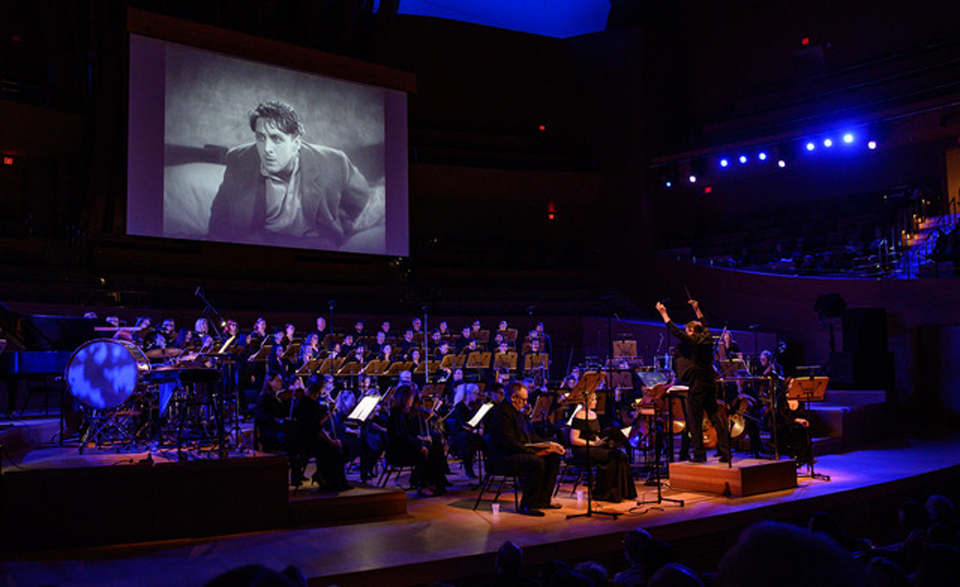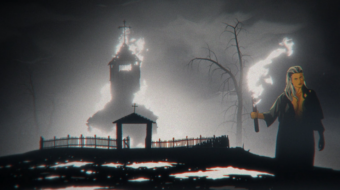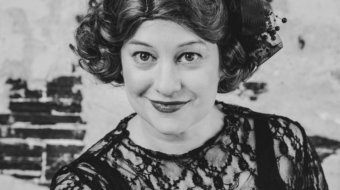
LOS ANGELES—This is a film town But there’s no period at the end of that sentence because L.A. is so much more. Not heavy industry so much, except the port, overland shipping and warehousing, and it’s probably the most productive garment center in the United States now. It’s a transportation hub and a generator of ideas, with great universities, museums, a philharmonic orchestra that ranks among the most highly regarded in the world, several critically important opera companies, a vibrant literary life. It’s also one of the strongest union towns in the country, and politically about as liberal as they come.
Still, film does exert a mesmerizing fascination. Sunday night, Jan. 26, at Walt Disney Concert Hall was a memorable night in L.A. film history.
Cineastes will recall the name and work of German filmmaker F.W. Murnau (born Friedrich Wilhelm Plumpe), who died in 1931 at the age of 42 in Santa Barbara after a traffic accident. He left behind a handful of films, mostly silents, including the 1922 Nosferatu, a Dracula adaptation and a prime example of German Expressionist cinema. Later films included the 1924 The Last Laugh and a 1926 version of the Faust story. Invited by William Fox to Hollywood in 1926 and given carte blanche to create what he wanted, he made three films: Sunrise: A Song of Two Humans (1927), with a screenplay by Carl Mayer, was first, an unfortuitous opening only two weeks before The Jazz Singer, regarded as the first “talkie,” followed by 4 Devils (1928) and City Girl (1930). Critics and film historians have regarded Sunrise as one of the best films ever made, rating number “82 on the American Institute of Film’s updated list of the 100 greatest American films,” according to program annotator Thomas May, even though with the advent of the “talkies” it soon passed into the annals of film history unremembered by most filmgoers. His final film, opening a week after his death, was Tabu, filmed in Bora Bora.
Few silent movies came with musical scores. Occasionally one might be composed, or assembled from snatches of already extant music, and a live orchestra might play it to accompany the showing. More usually, a local pianist or organist would improvise a transitory score to reflect and comment on the visual imagery. (It helped if s/he had seen the film in advance to anticipate what was coming and plan for it, but there are many stories of musicians who inadvertently played music that turned out to be totally inappropriate for the scene.) Even when the film itself was of mediocre quality, audiences flocked to theaters where well-known musicians were accompanying the screening. Musicians often liked to play little musical jokes in sync with the film. For many filmgoers, it was their first exposure to some of the most significant themes from the classical repertoire.
One such movie pianist was Irene Beal in Boise, Idaho. She introduced her grandson Jeff to jazz, and he went on to the Eastman School of Music to study jazz trumpet and composition in the 1980s. He met his wife Joan, a singer, there. Jeff Beal made his way to Hollywood, where he has become an established film composer and Emmy winner responsible for House of Cards and Blackfish. The Beals are in their late fifties.
Beal had always known about Sunrise, which occupies a unique place in film history. The very first Academy Awards ceremony took place on May 16, 1929, recognizing films that premiered in 1927-28. Sunrise took three awards that night: one for Best Actress (Janet Gaynor as the Wife), one for Best Cinematography (Charles Rosher and Karl Struss), and a special award never repeated again, Best Unique and Artistic Picture, meant as a counterpoint to a picture with more obvious commercial value.
After writing a short choral piece for the Los Angeles Master Chorale in 2017, Beal proposed for them an entirely new score for orchestra and voices to accompany Sunrise, which until now had a Movietone soundtrack by the uncredited Hugo Riesenfeld (it was the first film to employ Movietone technology), as well as other alternative scores over the years, but all of them undistinguished.
Sunday night, Jan. 26, was the premiere performance—and only one so far—of Jeff Beal’s score, written to a text compiled by and partially written by his wife Joan, who earlier in her career sang in the L.A. Master Chorale under director Paul Salamunovich.
As a silent film, obviously the characters have no voices, and Murnau is rather sparing even in his use of title cards. The story is meant to be archetypal, mythical, almost timeless, with characters identified only as the “two humans,” Man and Wife (George O’Brien and Janet Gaynor), although there is a very prominent role for the stylish seductress (Margaret Livingston). The Woman from the City is also unnamed because she is just one of any number of distractions from marital fidelity that modern life offers.
The filmmaker aimed to explore Jungian concepts of the “shadow” in everyone’s personality, and the eternal dualities of male/female, lust/chastity, city/country, night/day, authentic/artificial. The cinematography is experimental and often dreamlike, using montage and other special effects in a manner reminiscent of the classic Soviet films of the 1920s. Although filmed in America, the country houses bear a strong resemblance to German farm buildings, and the rushing city scenes feature the most contemporary of Bauhaus and Moderne design and futuristic architecture. Sunrise is, again according to Thomas May, “a fascinating hybrid of American and German elements.”
The film is 94 minutes, and the Master Chorale is standing and singing the whole time, occasionally joined by three soloists—Michael Lichtenauer, Holly Sedillos, and Suzanne Waters, significantly, one tenor and two sopranos, mirroring the triangle in the film but not literally portraying any particular characters. Since the hall is darkened so that we can watch the film, we cannot read the printed libretto, nor are the words projected anywhere. The artists are well aware of this paradox: That an entire cantata, shall we say, in eighteen separate parts, each one with lots of words, is for all practical purposes undecipherable. Indeed, some of the texts are in French and German, and left untranslated, but for intelligibility it might as well all have been Greek.
Odd, perhaps. But a potent gesture of artists from 2020 saluting their forebears in Los Angeles from almost a century ago, not so much to explain or amplify the original work of art but to pay it homage with a new work in its spirit as its companion. As Jeff Beals said pre-concert, “Out West we feel free to reinvent ourselves.”
“This song of the Man and his Wife is of no place and every place,” says the opening title card in the film; “you might hear it anywhere at any time.” By capturing verses as disparate as Hesiod’s Theogony, the Biblical Song of Solomon, the 19th-century German poet Theodor Storm, poet Hilda Doolittle (aka H.D.), the “Peasant Dance” verse by Adelheid Wette used in the opera Hänsel und Gretel by Engelbert Humperdinck (the original one!), and including poetry of her own, Joan Beal has created a parallel text that mirrors the visual footage. She expanded some of archetypal dualisms to include, as Thomas May quotes her, “above/below the staff, lyrical/nonsensical, beautiful/guttural, strong/weak, new/familiar. The musical score integrates all of these elements.”
Citing the fact that F.W. Murnau was gay, May quotes the composer sensing that “things that couldn’t be said or spoken were part of his thinking and part of his internal narrative about sexuality. The idea of someone so free and uninhibited” as the Woman from the City “is a powerful force in the movie, at a time when nothing was graphic.” Murnau came to America from Weimar Germany, which at the time was perhaps the most sexually “liberated” place on Earth, with gay and lesbian bars and clubs catering to every taste.

Sometimes there seemed to be a very close relationship between image and word, such as the word “drink” or (German) “trink” and “tanz,” dance) “quoting” the actors performing those actions at just those moments, while other times the music and text inhabited the mood of the scene without restating it. Joan Beal says, “I want this to wash over you.”
All this is rather curious, and explains why intelligibility was not the highest priority for the Beals. Any film composer knows that once you introduce the human voice into a score, it can be very distracting, taking attention away from the scene and the script to pay attention to the lyrics. If a song or other vocal music is used in the score it is always for a specific reason, to help define a moment or place, or to expand on a character’s inner thoughts and feelings. In Sunrise, the vocal score is meant to be immersive, the masterful voices just another set of instruments providing accompaniment to a classic film that might otherwise have sunk into historical oblivion. A request for a raise of hands at the pre-concert talk showed that most in the audience had never seen the film. As a listener/viewer, I wondered if a re-release of the film with this score is possibly in the works. It should be!
This is the most unusual movie music I have ever encountered, constantly on the move, with a variety of technical and musicological secrets buried within. Many forms are explored, from pop song to serious German Lied to hymn to fugue to swelling orchestral sonorities. It’s bombastic in places, and almost Wagnerian in weight and gravity. Frankly, I believe it could have success as a stand-alone concert piece without the film, but with the audience allowed to read along with the libretto.
The plot can be briefly summarized—and my colleague Ed Rampell will have to put up with me “spoiling” this 93-year-old film that anyone can Google. A beautiful, classy, unnamed young Woman from the City is vacationing in the country and catches the eye of a handsome local farmer, who his married with a child. They start an affair and she talks him into drowning his wife in the lake, overturning the boat and pretending it was an accident. She tells him to store a bundle of bullrushes in the boat that he can grab onto as a flotation device to save himself. He has second thoughts about the crime, but his weird behavior (and Beal’s scary music) on the boat ride frighten the Wife. On the other side of the lake the Wife boards a trolley into town, and he hops on as well, trying to make amends. It takes a whole day in the city, on the trolley, in the café, in the church where a wedding is in progress, in a barbershop, in a photographer’s studio, out and about on the streets and in a fancy night club to gradually seal their commitment to one another again.
At the night club the dancers are doing all the latest moves but Man and Wife remain on the sidelines. Then the orchestra starts up a “Peasant Dance” and Man and Wife go into a charming country dance routine that could be described as a folk jitterbug, fully as artistic, variegated and athletic as anything the ballroom dancers do. The other dancers watch admiringly and applaud at the end of the song—and the LAMC on stage clap their hands too as part of the score! At the end of the day the couple, having affirmed their love for the farming life and for one another, return to the lake to row back to their farm on the other side. But a sudden storm breaks out and both go overboard. He manages to make it to shore, but she does not. A search party finds stray reeds from the bundle of bullrushes and she is presumed drowned. Back on land the Woman from the City watches the scene believing the Man has drowned his Wife for her. The Man, however, finds the Woman from the City and is halfway through strangling her when word comes that the Wife has been found alive, clinging to the remaining stalks of bullrushes. The tide had lifted her around a point, which an old fisherman knowing the waters guessed might be the case. The Man leaves off strangling the Woman, so she was “saved” by the Wife, and he rejoins his loving Wife, who had been “saved” by the bullrushes. The sun rises on a timeless new era for Man and Wife.
The women’s voices are dominant in Beal’s score. In their pre-concert talk, the Beals shared a revealing anecdote. He watched the film and spoke of it to her as a lyrical love poem for a married couple—just like their own 35-year marriage! Then Joan saw it and, as quoted in the Los Angeles Times (Jan. 22), said, “Hon, this is kind of a monster movie. She’s a vulnerable woman, because she can’t make her own living, she’s raising a child, she’s completely dependent on this man for everything, for her livelihood, for her life. He’s her protector. So to have that person turn against her and become something that could kill her—yeah, it’s terror.”
A different kind of terror forms the underplayed substratum of the film. The vacationtime visits to the countryside by the city slickers are harbingers of vast social changes that are clearly afoot. “Property lenders from the city strip the farm,” reads an early title in the film. In their first love scene between the Man and the Woman from the City, they kiss rapturously as she says, “Tell me you are all mine! Sell your farm and come with me to the city. Come to the city!” She not only symbolizes liberation and lust, but also capitalist encroachment on the countryside. The theme is recapitulated late in the film when we see her reading a newspaper as the camera pans in on an ad that encourages farmers to sell their property. For Murnau to introduce this theme at least three times is clearly no accident.

As the nearby city expands, requiring a ready workforce, these farmlands the Man and Wife so happily till now will soon be leveled for suburban residential towns and communities, and sooner or later probably districts of the city itself. Call it the work of evil speculators if you will, but it’s the story of 20th-century urbanization. Like it or not, Man and Wife will become proletarianized. The sunrise that titles and visually ends the film is a darkly ironic mirage of a pastoral idyll, in the end another Hollywood illusion, with inevitable new stresses by the time the sun sets on Man and Wife.
Grant Gershon, artistic director of the LAMC, conducted the score with a monitor of the spooling film placed directly in front of him so he could constantly check his tempos to be on track with the images the audience was seeing. It must have been a formidable job to coordinate film with orchestra with a 40-person chorus with vocal soloists, but it seemed to go without a hitch.
New film scores to old movies are not a new thing. In fact, back in 2016 at Halloween, Los Angeles Opera premiered a new collage of a score assembled by its composer in residence, Matthew Aucoin, to Murnau’s Nosferatu. Other new scores have been commissioned as well.
But the grandeur and scope of the Beals’ music and text take the project of re-scoring into an entirely new dimension. The Los Angeles Master Chorale has earned many well-deserved bravos since its founding in 1964. This big throw might have topped them all.










